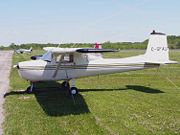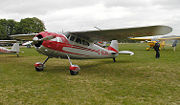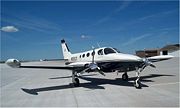Cessna
| Type | Subsidiary |
|---|---|
| Founded | 1927 |
| Headquarters | Wichita, Kansas |
| Key people | Jack J. Pelton (Chairman, President, and CEO) |
| Industry | Aerospace |
| Products | General aviation aircraft Business jets |
| Employees | 15,000[1] |
| Parent | Textron |
| Subsidiaries | Columbia Aircraft |
| Website | www.cessna.com |
The Cessna Aircraft Company is an airplane manufacturing corporation headquartered in Wichita, Kansas. Their main products are general aviation aircraft. Although they are the most well-known for their small, piston-powered aircraft, they also produce business jets.
Contents |
History
The company traces its history to June 1911, when Clyde Cessna, a farmer in Rago, Kansas, built a wood-and-fabric plane and became the first person to build and fly an aircraft between the Mississippi River and the Rocky Mountains.
Clyde Cessna started his aircraft ventures in Enid, Oklahoma, testing many of his early planes on the salt flats. When bankers in Enid refused to loan him more money to build his planes, he moved to Wichita.[2]
In 1924, Cessna partnered with Lloyd C. Stearman and Walter H. Beech to form the Travel Air, Inc., a biplane manufacturing firm. This company was based in Wichita. In 1927, Clyde Cessna left Travel Air and formed his own company, the Cessna Aircraft Company. Instead of producing biplanes, he instead decided to focus on building monoplanes. The first flew on August 13, 1927.
Cessna Aircraft Company closed its doors from 1932–1934 due to the state of the economy. In 1934, Dwane Wallace, with the help of his brother Dwight, took control of the company and began the process of building it into what would become a global success.[3]
After World War II, Cessna created the 170, which, along with later models (notably the 172), became the most widely produced light aircraft in history. Cessna's advertising boasts that its aircraft have trained more pilots than those of any other company.
In 1985 Cessna was bought by General Dynamics Corporation and in 1986 production of piston-engine aircraft was suspended. General Dynamics cited product liability as the cause. The then-CEO Russ Meyer said that production would resume if a more favorable product liability environment developed. In 1992, Textron Inc. bought Cessna and, after passage of the General Aviation Revitalization Act of 1994, resumed production of the piston-engine 172, 182, and 206 designs.
On 27 November 2007 Textron announced that Cessna had purchased the bankrupt Columbia Aircraft company for US$26.4M and would continue production of the Columbia 350 and 400 as well as the Cessna 350 and Cessna 400 at the Columbia factory in Bend, Oregon.[4][5] There had been speculation that the acquisition of the Columbia line would spell the end of the Cessna NGP project, but on September 26, 2007, Cessna Vice President for Sales, Roger Whyte, confirmed that development of the NGP project will continue, unaffected by the purchase of Columbia.[6]
Since November 2007 the company has been involved in a public controversy regarding the contracting of production of the Cessna 162 SkyCatcher to the Shenyang Aircraft Corporation of the People's Republic of China.[7]
Currently, Cessna produces 2-, 4- and 6-place single-engine airplanes, utility turboprops, and business jets.
Chinese production controversy
On 27 November 2007, Cessna announced the new Cessna 162 would be made in the People's Republic of China by Shenyang Aircraft Corporation, which is a subsidiary of China Aviation Industry Corporation I (AVIC I), a Chinese government-owned consortium of aircraft manufacturers.[8] By manufacturing the aircraft in China, Cessna reports it saved USD$71,000 in production costs per aircraft, or about 40% of the cost. A second reason cited for moving production to Shenyang Aircraft Corporation was Cessna has no plant capacity available in the USA.[7]
Cessna received a high degree of negative feedback from 162 customers and potential customers regarding this decision. Complaints centered around the recent problems with Chinese production of other consumer products, China's human rights record, exporting of jobs, and China's less than friendly political relationship with the USA.[9] The backlash surprised Cessna and resulted in a company public relations campaign to try to explain the decision from a business perspective and assure customers that quality of the aircraft will not be compromised.[10] The reaction to the explanations and assurances has been overwhelmingly negative, although a small number of customers have applauded the production in China.[9]
2008 economic crisis
On 4 November 2008 Cessna's parent company, Textron, indicated that Citation production would be reduced from the original 2009 target of 535 "due to continued softening in the global economic environment" and that this would result in an undetermined number of lay-offs at Cessna.[11]
On 8 November 2008 at the AOPA Expo, CEO Jack Pelton indicated that while Cessna sales of aircraft to individual buyers have fallen that piston and turboprop sales to business have not. "While the economic slowdown has created a difficult business environment, we are encouraged by brisk activity from new and existing propeller fleet operators placing almost 200 orders for 2009 production aircraft," Pelton stated.[12][13]
On 13 November 2008 Cessna announced that a total of 665 jobs will be cut at its Wichita and Bend, Oregon plants starting in January 2009. The Cessna factory at Independence, Kansas which builds the Cessna piston-engined aircraft and the Cessna Mustang, will not see any lay-offs but one third of the workforce at the former Columbia Aircraft facility in Bend will be laid off. This will total 165 of the 460 employees who build the Cessna 350 and 400. The remaining 500 jobs will be lost at the main Cessna Wichita plant.[14]
Marketing Initiatives
Cessna has always had an active marketing department. This was especially notable during the 1950s and 1960s. During this period, the marketing department followed the lead of Detroit automobile manufacturers and came up with many marketing slogans and buzzwords to describe Cessna’s product line in an attempt to place their products ahead of the competition.
Other manufacturers and the aviation press widely ridiculed and spoofed many of these marketing terms but between Cessna’s designers producing a product the flying public wanted and the work of the marketing department, Cessna built and sold more aircraft than any other manufacturer during the boom years of the 1960s and 1970s.









Marketing buzzwords
Cessna marketing buzzwords included:
- Para-Lift Flaps – these were the large fowler flaps Cessna introduced on the 170B in 1952, replacing the narrow chord plain flaps then in use.[15]
- Land-O-Matic – In 1956, Cessna introduced sprung-steel tricycle landing gear on the 172. The marketing department chose “Land-O-Matic” to imply that the these aircraft were much easier to land and take-off than the preceding conventional landing gear equipped Cessna 170. They even went as far as to say pilots could do “drive-up take-offs and drive-in landings”, implying that flying these aircraft was as easy as driving a car. In later years some Cessna models had their steel sprung landing gear replaced with steel tube gear legs. The 206 retains the original spring steel landing gear today.[15]
- Omni-Vision – This referred to the rear windows on some Cessna singles, starting with the 182 and 210 in 1962, the 172 in 1963 and the 150 in 1964. The term was intended to make the pilot feel visibility was improved on the notably poor-visibility Cessna line. The introduction of the rear window caused most models a loss of cruise speed due to the extra drag, while not adding any useful visibility.[15]
- Cushioned power – This was to announce the introduction of rubber mounts on the cowling of the 1967 model 150, in addition to the rubber mounts isolating the engine from the cabin.
- Omni-Flash - This referred to the flashing beacon on the tip of the fin that could be seen all around.
- Open-View – This referred to the removal of the top section of the control wheel in 1967 models. These had been rectangular, they now became “ram’s horn” shaped, thus not blocking the instrument panel as much.
- Quick-Scan – Cessna introduced a new instrument panel layout in the 1960s and this buzzword was to indicate Cessna’s panels were ahead of the competition.
- Nav-O-Matic - This was the name of the Cessna autopilot system, which implied the system was relatively simple.
Aircraft models
- Cessna NGP
- Cessna CH-1 Helicopter
- Cessna A
- Cessna BA
- Cessna AW
- Cessna AT-17 Bobcat
- Cessna C-34 Airmaster
- Cessna T-37
- Cessna 120
- Cessna 140
- Cessna 150 Commuter, Patroller & Aerobat
- Cessna 152
- Cessna 160
- Cessna 162 Skycatcher
- Cessna 165 Airmaster
- Cessna 170
- Cessna 172 Skyhawk, T-41 Mescalero
- Cessna 175 Skylark
- Cessna 177 Cardinal
- Cessna 180 Skywagon
- Cessna 182 Skylane
- Cessna 185 Skywagon
- Cessna 187
- Cessna 188 AGwagon, AGpickup, AGtruck, and AGhusky
- Cessna 190
- Cessna 195
- Cessna 205 Super Skywagon
- Cessna 206 Stationair & Super Skylane
- Cessna 207 Skywagon, Stationair 7 & 8
- Cessna 208 Caravan
- Cessna 210 Centurion
- Cessna 303
- Cessna 305 Birddog
- Cessna 310
- Cessna 320 Skyknight
- Cessna 335
- Cessna 336 Skymaster, O-2 Skymaster
- Cessna 337 Skymaster
- Cessna 340
- Cessna 350 formerly the Columbia 350
- Cessna 400 formerly the Columbia 400
- Cessna 401 Utiliner and Businessliner
- Cessna 402 Utiliner and Businessliner
- Cessna 404 Titan II
- Cessna 406 Caravan II
- Cessna 411
- Cessna 414 Chancellor
- Cessna 421 Golden Eagle
- Cessna 425 Conquest I
- Cessna 441 Conquest II
- Cessna 500 Citation I
- Cessna 501 Citation ISP
- Cessna 510 Citation Mustang
- Cessna 525 CitationJet, CJ1, CJ1+
- Cessna 525A CJ2, CJ2+
- Cessna 525B CJ3
- Cessna 525C CJ4
- Cessna 550 Citation II, Cessna Citation Bravo
- Cessna 551 Citation IISP
- Cessna S550 Citation SII
- Cessna 560 Citation V, Citation Ultra, Citation Encore, Citation Encore+
- Cessna Citation 560XL Excel, XLS, XLS+
- Cessna 620
- Cessna 650 Citation III, Citation VI, Citation VII
- Cessna 680 Citation Sovereign
- Cessna 750 Citation X
- Cessna 850 Citation Columbus
References
- ↑ Cessna Aircraft Company (2008). "About Cessna - Overview". Retrieved on 2008-11-12.
- ↑ Article in "Enid News"
- ↑ Phillips, Edward H: Wings of Cessna, Model 120 to the Citation III, Flying Books, 1986. ISBN 0-911139-05-2
- ↑ Textron (November 2007). "Textron's Cessna Aircraft Company to Acquire Assets of Columbia Aircraft". Retrieved on 2007-11-28.
- ↑ Russ Niles (2007-11-27). "Cessna Gets Columbia". Retrieved on 2007-11-29.
- ↑ "AVweb's NBAA 2007 Podcast #2: A Low-Wing Cessna Single? Cessna's Roger Whyte Explains Why It Makes Sense" (2007-09-26). Retrieved on 2007-10-01.
- ↑ 7.0 7.1 Russ Niles (2007-11-27). "Skycatcher To Be Made in China". Retrieved on 2007-11-29.
- ↑ Textron (November 2007). "Cessna Chooses China's Shenyang Aircraft Corporation as Manufacturing Partner for Model 162 SkyCatcher". Retrieved on 2007-11-28.
- ↑ 9.0 9.1 Aniello, Tom (December 2007). "Making the case for building the SkyCatcher in China (entire website since deleted)". Retrieved on 2008-01-03.
- ↑ Grady, Mary (January 2008). "Germany's Remos Aircraft Expanding, Challenges Cessna". Retrieved on 2008-01-03.
- ↑ Grady, Mary F. (November 2008). "Cessna Slows Citation Production, Citing Global Economy". Retrieved on 2008-11-06.
- ↑ Niles, Russ (November 2008). "It's a Buyer's Market". Retrieved on 2008-11-08.
- ↑ Durden, Chris (November 2008). "Cessna Announces Possible Layoffs". Retrieved on 2008-11-04.
- ↑ Niles, Russ (November 2008). "Eclipse Misses Payroll: TV Report". Retrieved on 2008-11-13.
- ↑ 15.0 15.1 15.2 Clarke, Bill: Cessna 150 and 152 first edition, pages 5-17. TAB Books, 1987. ISBN 0 8306-9002-0
External links
- Company website
- PilotFriend.com - Cessna company history and aircraft types details
- "Patents owned by Cessna Aircraft Company". US Patent & Trademark Office. Retrieved on December 5, 2005.
|
|||||||||||||||||
|
||||||||||||||